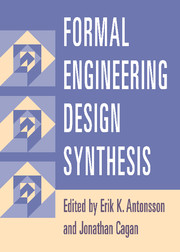Book contents
- Frontmatter
- Contents
- Contributing Authors
- Foreword
- Preface
- Introduction
- 1 Vitruvius Redux
- 2 How to Calculate with Shapes
- 3 Engineering Shape Grammars
- 4 Creating Structural Configurations
- 5 Microsystem Design Synthesis
- 6 Function-Based Synthesis Methods in Engineering Design
- 7 Artificial Intelligence for Design
- 8 Evolutionary and Adaptive Synthesis Methods
- 9 Kinematic Synthesis
- 10 Systematic Chemical Process Synthesis
- 11 Synthesis of Analog and Mixed-Signal Integrated Electronic Circuits
- 12 Mechanical Design Compilers
- 13 Scientific Discovery and Inventive Engineering Design
- Index
1 - Vitruvius Redux
Formalized Design Synthesis in Architecture
Published online by Cambridge University Press: 10 October 2009
- Frontmatter
- Contents
- Contributing Authors
- Foreword
- Preface
- Introduction
- 1 Vitruvius Redux
- 2 How to Calculate with Shapes
- 3 Engineering Shape Grammars
- 4 Creating Structural Configurations
- 5 Microsystem Design Synthesis
- 6 Function-Based Synthesis Methods in Engineering Design
- 7 Artificial Intelligence for Design
- 8 Evolutionary and Adaptive Synthesis Methods
- 9 Kinematic Synthesis
- 10 Systematic Chemical Process Synthesis
- 11 Synthesis of Analog and Mixed-Signal Integrated Electronic Circuits
- 12 Mechanical Design Compilers
- 13 Scientific Discovery and Inventive Engineering Design
- Index
Summary
PARTICULATE COMPOSITION
A quarter of a century ago I published a paper titled “Vitruvius Computatus” (Mitchell, 1975). In it I argued that, if computer systems achieved the capacity to execute nontrivial architectural design tasks, we could “expect the designs which emerge from them to be characterized by particular stylistic traits.” I went on to suggest, more specifically, “If computer systems become architects they may be academic classicists, heirs to Durand and Guadet.” Sadly, I turned out to be right.
Jean N. L. Durand and Julien Guadet were great French architectural pedagogues, and authors of highly influential texts that were used by generations of students. They provided models to copy, and they promulgated a view of architectural composition that was essentially particulate and combinatorial. Within the tradition that Durand and Guadet established and formalized, designers relied heavily upon abstract ordering devices such as grids and axes, and they would typically begin a project by exploring various combinations of these devices to produce an organizing skeleton of construction lines (Figure 1.1). Guided by this skeleton, they would then consider alternative ways to arrange the major rooms and circulation spaces. Finally, they would develop the design by deploying elements from an established vocabulary of construction elements – columns, entablatures, doors, windows, and so on. As Durand's famous plates illustrated (Figure 1.2), it was a recursive process of top-down substitution.
Thus, learning to design was much like learning Latin prose composition.
- Type
- Chapter
- Information
- Formal Engineering Design Synthesis , pp. 1 - 19Publisher: Cambridge University PressPrint publication year: 2001
- 4
- Cited by



